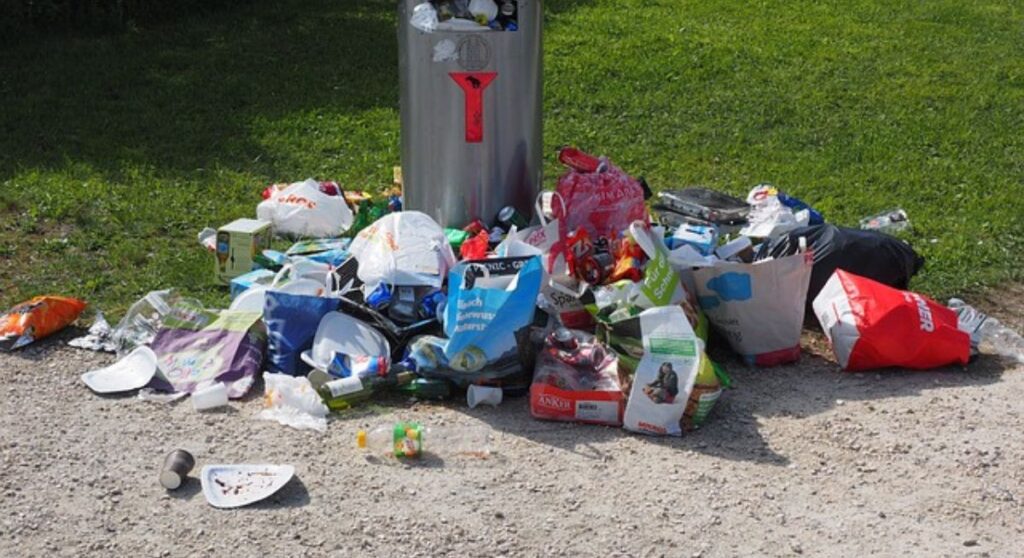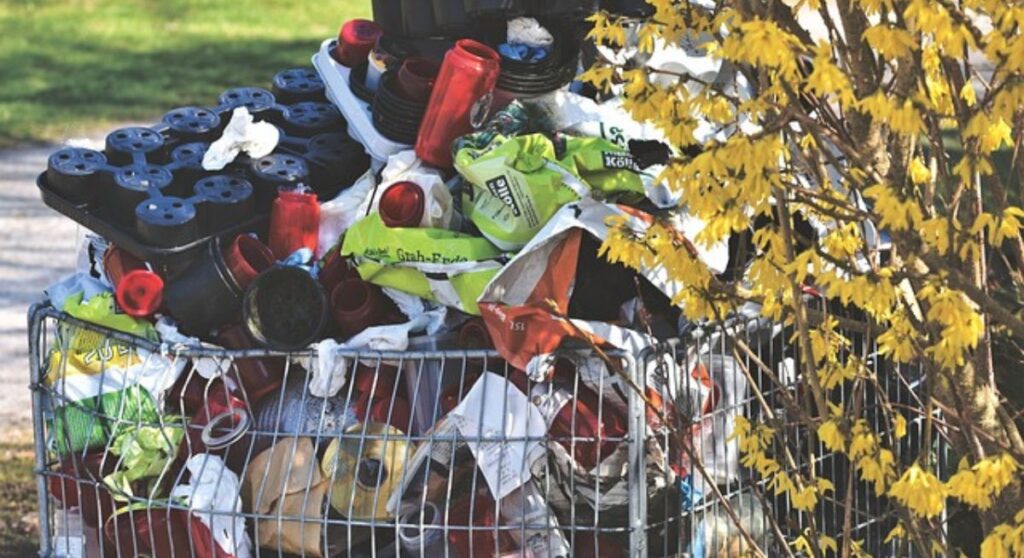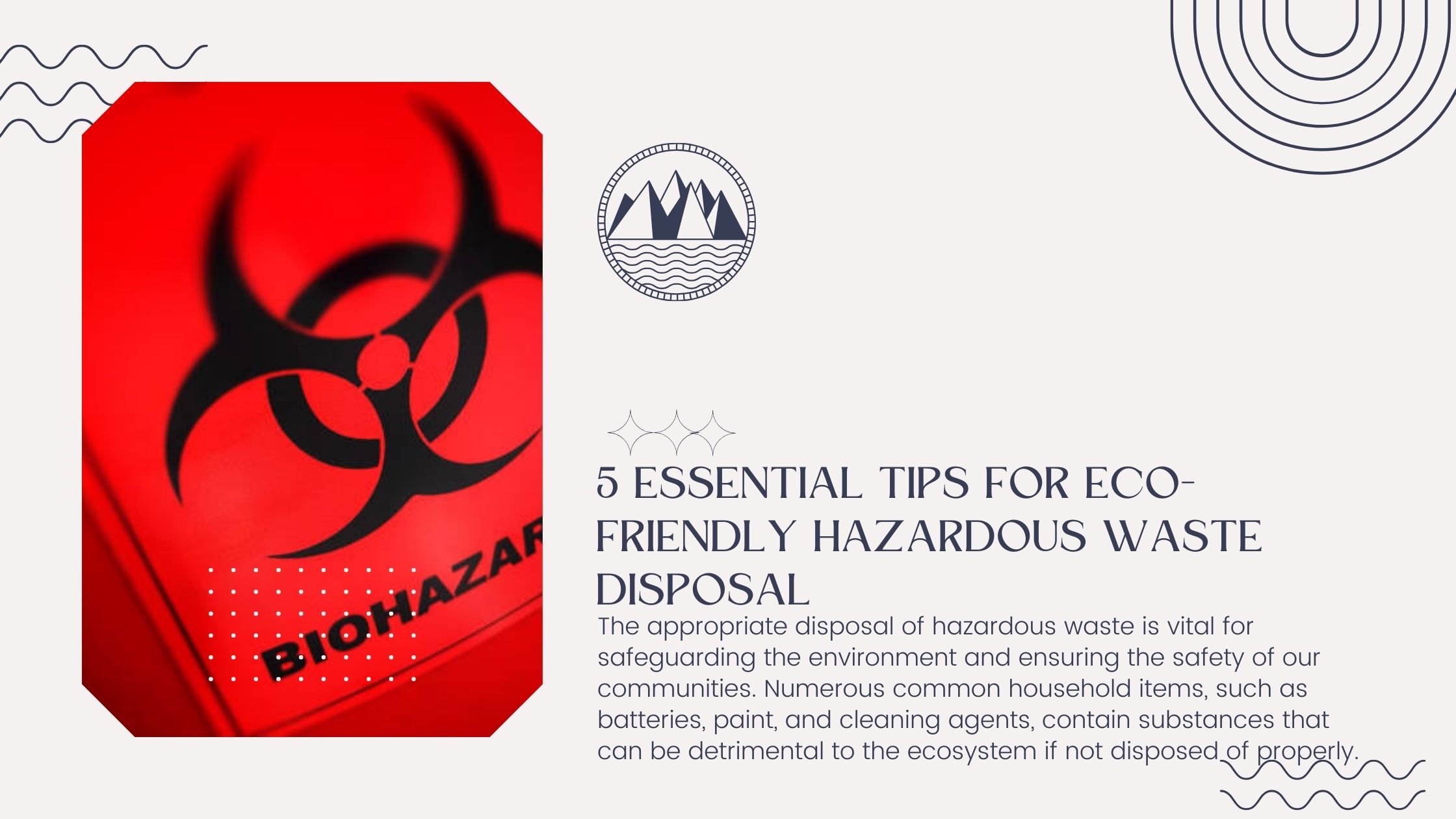Introduction:-
5 Essential Tips for Eco-Friendly Hazardous Waste Disposal

The appropriate disposal of hazardous waste is vital for safeguarding the environment and ensuring the safety of our communities. Numerous common household items, such as batteries, paint, and cleaning agents, contain substances that can be detrimental to the ecosystem if not disposed of properly. This article will discuss five important guidelines for environmentally responsible hazardous waste disposal, enabling you to contribute positively to the planet..
5 Essential Tips for Eco-Friendly Hazardous
1. Recognize Hazardous Waste in Your Residence
Not all waste possesses the same level of risk. Certain household items are deemed hazardous due to their chemical composition, which poses a threat to soil, water, and air quality. Common examples of hazardous waste include:
• Batteries (particularly lithium and alkaline)
• Paints, varnishes, and stains
• Pesticides and herbicides
• Motor oil and antifreeze
• Fluorescent light bulbs
• Household cleaners that contain bleach or ammonia
To ensure safe disposal, examine product labels for warnings such as “Caution,” “Danger,” or “Poison.” These items should never be discarded in regular trash, as they may release harmful substances into landfills.
2. Utilize Local Hazardous Waste Collection Services
A practical approach to responsibly disposing of hazardous materials is to take advantage of your community’s hazardous waste collection programs. Numerous municipalities organize drop-off events or maintain designated facilities where hazardous materials can be delivered for appropriate disposal or recycling.
Visit your local government’s website to find a schedule of hazardous waste collection events or a list of permanent collection sites. These facilities are designed to manage materials safely, thereby preventing environmental contamination.
3. Recycle Whenever Feasible
Recycling represents one of the most environmentally friendly methods for disposing of hazardous waste. Many hazardous materials can be repurposed into new products, thereby decreasing the demand for virgin resources and lessening environmental impact.
For instance:
• Batteries: Most electronics retailers and recycling centers accept used batteries for recycling.
• Motor Oil: Numerous auto repair shops and service stations will accept used motor oil for recycling.
• Paint: Unused paint can often be donated to local charities, or some retailers may provide recycling options.
Always investigate local recycling regulations to determine which hazardous materials can be recycled in your area.
4. Safely Store Hazardous Waste Prior to Disposal
It is crucial to ensure the safe storage of hazardous waste until it can be transported to a designated collection center or recycling facility. Retain hazardous materials in their original containers, ensuring that the lids are securely fastened to prevent any leakage. These materials should be kept in a cool, dry environment, away from heat sources, pets, and children.
Furthermore, it is imperative not to combine different types of hazardous waste, as this may lead to hazardous chemical reactions. Clearly label all containers to facilitate easy identification when the time for disposal arrives.
5. Explore Environmentally Friendly Alternatives
A highly effective strategy for minimizing hazardous waste is to prevent its creation altogether. Seek out environmentally friendly alternatives to commonly used hazardous products. For instance:
• Choose natural cleaning agents composed of ingredients such as vinegar, baking soda, and lemon juice.
• Utilize non-toxic paints and stains that do not contain harmful chemicals.
• Substitute conventional pesticides with organic gardening solutions to maintain a pest-free garden without resorting to harmful chemicals.
By opting for greener alternatives, you can significantly decrease the volume of hazardous waste generated, thereby enhancing the safety and sustainability of your home.
What types of hazardous waste can be recycled?
Various categories of hazardous waste can be recycled, thereby mitigating their environmental effects and preserving resources. Notable examples include:
1. Used Oil: Motor oils and other industrial lubricants can be purified and reused.
2. Batteries: Lead-acid batteries (such as those used in vehicles), lithium-ion, and nickel-cadmium batteries can be processed to extract valuable metals including lead, lithium, and cadmium.
3. Electronic Waste (E-Waste): Devices such as computers and smartphones contain hazardous substances like mercury and lead, which can be recycled to reclaim metals and reduce pollution.
4. Fluorescent Lamps: These lamps contain mercury, which can be extracted and repurposed in the production of new bulbs.
5. Aerosol Cans: When managed correctly, the metal and residual chemicals can be recycled.
6. Solvents: Industrial solvents, including acetone and paint thinners, can be distilled for reuse.
7. Antifreeze: Antifreeze based on ethylene glycol can be filtered and purified for subsequent use.
Recycling these materials is essential for preventing soil and water contamination while recovering valuable resources.
Why is proper hazardous waste disposal important for the environment?
Effective disposal of hazardous waste is essential for environmental protection for several reasons:

1. Prevention of Soil and Water Contamination: When hazardous waste is not disposed of correctly, it can infiltrate the soil and contaminate groundwater. This poses risks to ecosystems, flora, fauna, and even human drinking water, leading to potential health hazards.
2. Reduction of Air Pollution: Certain hazardous materials emit toxic gases when incinerated or exposed to the atmosphere. Proper disposal methods ensure that these substances are managed in a manner that minimizes harmful air emissions.
3. Protection of Wildlife: Numerous hazardous wastes are detrimental to wildlife. Inappropriate disposal in landfills or aquatic environments can endanger animals, disrupt natural habitats, and contribute to the decline of various species.
4. Mitigation of Human Health Risks: Contact with hazardous waste can result in numerous health complications, including respiratory issues, skin conditions, organ damage, and cancer. Safe disposal practices help to lower the risk of both direct and indirect exposure to these dangerous materials.
5. Reduction of Long-Term Environmental Damage: Hazardous waste, particularly substances like heavy metals and persistent organic pollutants, can persist in the environment for many years, inflicting lasting harm on ecosystems and food webs.
6. Adherence to Environmental Regulations: Proper disposal practices ensure compliance with legal standards designed to safeguard the environment, thereby minimizing the risk of legal repercussions and fostering sustainable practices.
By effectively managing hazardous waste, we safeguard ecosystems, preserve biodiversity, and protect human health, while also diminishing the environmental impact of both industries and households.
How can I reduce hazardous waste in my home?
Minimizing hazardous waste in your household is essential for environmental protection and fostering a safer living environment. Below are several strategies to effectively reduce hazardous waste:

1. Utilize Non-Toxic Alternatives:
• Cleaning Products: Transition to natural cleaning solutions composed of vinegar, baking soda, and lemon juice, avoiding chemical-laden cleaners.
• Pesticides and Herbicides: Select organic pest management techniques or natural substitutes for chemical pesticides and herbicides.
2. Purchase in Smaller Quantities:
• Acquire only what is necessary, particularly for products such as paints, solvents, and cleaners. This practice helps to limit surplus waste that may become outdated or necessitate disposal.
3. Opt for Rechargeable Batteries:
• Using rechargeable batteries decreases the volume of single-use batteries discarded, thereby reducing hazardous waste associated with battery components like lead and cadmium.
4. Store Hazardous Materials Properly:
• Ensure that chemicals such as paints, solvents, and cleaning agents are stored correctly to avert spills and leaks that could lead to contamination. Adhere to safety guidelines for storage to prolong their usability.
5. Recycle Electronics and Batteries:
• Dispose of electronic waste and batteries at appropriate recycling facilities instead of in regular trash. Numerous communities offer programs for recycling items such as smartphones, computers, and rechargeable batteries.
6. Implement Energy-Efficient Lighting:
• Replace fluorescent bulbs with LED lighting, as the latter does not contain mercury and does not require hazardous waste disposal.
7. Limit Use of Hazardous Materials in Home Projects:
• When undertaking home renovations, select water-based paints and stains over oil-based options that contain higher levels of toxic substances.
8. Compost Organic Waste:
• Compost kitchen organic waste instead of relying on chemical fertilizers in your garden, thereby decreasing the necessity for hazardous chemicals.
9. Dispose of Hazardous Waste Responsibly:
• Engage in community hazardous waste collection initiatives to safely discard items such as old paints, solvents, batteries, and electronics.
By implementing these practices, you can significantly decrease the volume of hazardous waste generated in your home.
Final Thoughts
Environmentally responsible hazardous waste disposal extends beyond merely eliminating harmful substances; it involves making deliberate choices to safeguard our ecosystem. By recognizing hazardous waste, engaging with local disposal initiatives, recycling, appropriately storing materials, and opting for more sustainable alternatives, individuals can significantly contribute to minimizing environmental damage.
Incorporate these practices into your waste disposal habits to ensure your contribution to the well-being of the planet. Responsible disposal today can pave the way for a cleaner and safer future.
References:
- U.S. Environmental Protection Agency (EPA) – Hazardous Waste Overview
- World Health Organization (WHO) – Hazardous Waste Impact
- Earth911 – How to Find Local Waste Disposal Programs
- Local Government Websites (Example: City of San Francisco – Household Hazardous Waste Disposal)
- CalRecycle – Guide to Hazardous Waste Recycling
- Call2Recycle – Battery Recycling Locations
- Firestone Complete Auto Care – Motor Oil Recycling
- PaintCare – Paint Recycling Options
- Energy Star – Fluorescent Bulb Disposal Guide
- ScienceDirect – Hazardous Waste Storage Safety
- Environmental Working Group (EWG) – Eco-Friendly Alternatives

